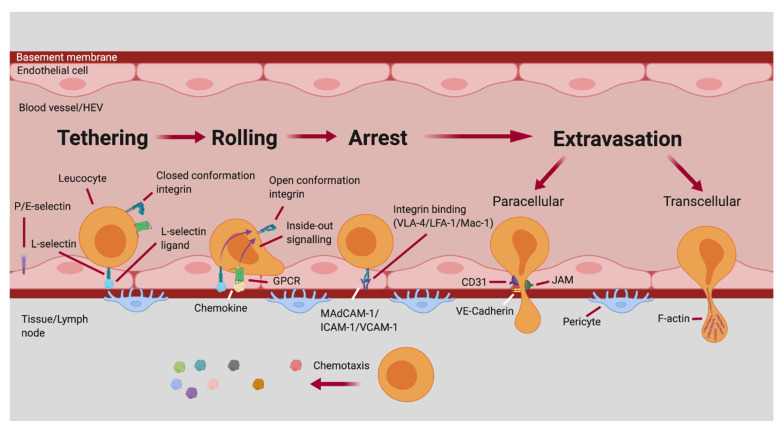Figure 2.
Leukocyte adhesion cascade within blood vessel/HEV. Leukocytes are recruited to lymph nodes or infected/inflamed tissues from high endothelial venules (HEVs) or inflamed blood vessels in a series of 4 major steps. Leukocytes tether to endothelium via the transmembrane receptors P-, E- or L-selectin which bind vascular addressins such as P-selectin glycoprotein 1 (PSGL-1), CD44 or peripheral lymph node addressin (PNAd). Leukocytes then slowly roll across the endothelium and come into contact with chemokines which bind G-protein coupled receptors (GPCRs). These events result in an inside-out signalling cascade stabilising integrin expression on the leukocyte such as leukocyte function-associated antigen 1 (LFA-1), very late antigen-4 (VLA-4) and macrophage antigen-1 (Mac-1) which bind mucosal vascular addressin cell-adhesion molecule 1 (MAdCAM-1), and immunoglobulin superfamily members intercellular cell-adhesion molecule-1 (ICAM-1) and vascular cell-adhesion molecule-1 (VCAM-1) on the endothelial cell surface. This causes arrest of the leukocyte onto the endothelium, ready for the final step of extravasation into the lymph node/tissue via paracellular or transcellular transmigration. Paracellular migration occurs via leukocyte interaction with junction adhesion molecules and release of VE-cadherin, which allows the leukocyte to pass between two endothelial cells. Transcellular migration occurs via F-actin rich podosomes on leukocytes passing through the cytoplasm of a single endothelial cell.

